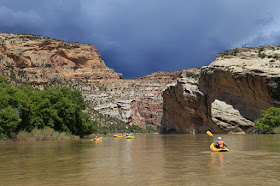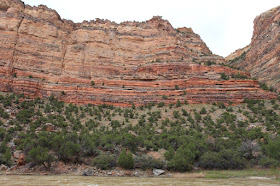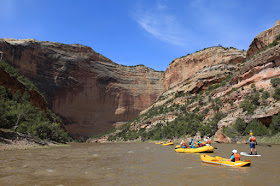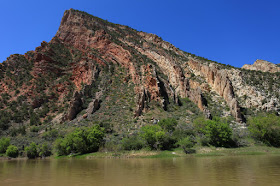This is the Yampa River at Deerlodge Park where the National Park Service maintains a ranger station and boat ramp in Dinosaur National Monument.
The cottonwood bosque was beautiful and I wish we could have camped here the night before.
The boats are ready in this downstream view from Deerlodge Park. Our outfitter was OARS (aka Don Hatch River Expeditions) and the crew were all fantastic and accommodating to our group of geology (and other) enthusiasts.
As we got on the water, a huge thunderstorm was developing downstream. We had excellent clouds on this trip, which is rather unusual for late May/early June.
The stratigraphic column for Dinosaur National Monument shows a striking similarity to rock units found farther south (image courtesy of Belknap river guidebook Westwater Press).
Further downstream within the canyon, the Pennsylvanian Upper Morgan Formation appears. It contains interbedded sandstone and limestone, signaling a change in depositional systems at this time, about 310 Ma. Similar rocks are found to the south (the Honaker Trail Formation (in Cataract and the San Juan River canyons) and the Supai Group (Grand Canyon).
Kayakers in the Yampa Canyon.
Even further along, the Lower Morgan Formation rises up above river level. It is composed mostly of soft shale. This unit has a major bearing on the shape of the canyon, as south dipping bedding planes in the shale have given way to create large prehistoric landslides into the canyon.
View of the Weber Sandstone (top) and the Upper Morgan Formation (brilliant colors below).
Spirifer brachiopod fossils from the Morgan Formation.
Scene looking upstream from our first nights camp at TeePee Camp. What a beautiful place!
Looking downstream to another location where the Lower Morgan Formation has slipped away into the river, leaving a juniper covered slope that dips to the south (left). The headwalls of the breakaway point are the cliffs in the distance (center).
A view of the "Yampatheaters" (Yampa amphitheaters). These may be periglacial features formed during the Ice Age. They are always found on the north-facing slopes, where snow may have accumulated to great thicknesses. The presence of water here may have carved recesses in the cliff.
We are now getting deeper into the rock stack as the river meanders through south-dipping strata. The Upper Morgan Formation forms the upper cliff, with the Lower Morgan Formation making the middle bench. Below that is a small cliff face of the Mississippian Round Valley Limestone, underlain by the Doughnut and Humbug formations (ledge and slope). The uppermost Madison Limestone is just poking out above the river in the distance.
We stopped at this syncline in the Round Valley Limestone to discuss how it may have formed. The guidebook and our geology guide Zach said that it might be a collapse feature formed on top of underlying karst. However, someone noticed that one of the interbedded shales was thrust to the left over itself. That might be compatible with karst collapse but a tectonic origin cannot be ruled out.
As the river generally trends from east to west, it also makes wide swings to the south and north. When it swings to the south (in the direction of dip) younger rocks come to the rivers side. When it goes north, older rocks. Here we see a southerly trend with a cliff of Weber Sandstone angling down to river level.
We saw a lot of Bighorn sheep on this trip.
Huge alcoves have formed where the Weber Sandstone overlies the Upper Morgan Formation. And in the shadows of these great alcoves grow stately Douglas fir trees, well below their normal elevational comfort zone. Shady winters provide more net effective moisture on these cool, north-facing slopes.
Check out those colors in the Upper Morgan Formation of alternating red sandstone and gray limestone! Most Colorado Plateau strata below this horizon are marine. Most strata above are terrestrial. This interval marks a giant change in depositional patterns in this part of the world.
The lower Weber Sandstone has a few mud partings that cause groundwater to seep out, leaving blackish streaks on the walls of the canyon.
Our second nights camp was at Harding Hole 4 (river campsites are preassigned within Dinosaur National Monument). Way up on the cliff where the gray, varnished top meets the more reddish middle, a perched river gravel remains.
This is a close-up of a portion of that deposit. Note how the gravel sits within a convex-up channel-form, likely an older course of the Yampa River before it had incised to its present level.
Morning scene at Harding Hole 4 camp.
Bedding features within the Weber Sandstone.
Chase on the stand-up paddle board.
A sandstone maze carved by the Yampa River.
These shots were taken in the highly meandering section of the Yampa, which is generally more to the south and where the Weber Sandstone comes down to river level. I wonder if the meanders were once also present upstream from here but before the river cut down into the Morgan Formation there? In other words, are the meanders (obviously formed when the river was positioned upon a more subdued terrain) preferentially preserved within the sandstone but then "straighten out" when a different rock type is incised into? The answer seems to be "yes" to me.
We are approaching the Grand Overhang of the Yampa River.
A closer view.
An upstream view.
A view while on our way past the topmost limestone in the Upper Morgan Formation.
The entire trip, we have been traveling parallel to the Yampa Fault, an east/west trending structure that is uplifted on the south side. In this south view, we get a glimpse across the fault. The Weber Sandstone is exposed next to the river on the right. Directly above the raft in the distance are the Park City, Moenkopi and Chinle formations. However, once the fault is crossed, the layers are uplifted dramatically and on the skyline is the Morgan Formation, just poking above the rivers edge on the right and on the downthrown side of the fault.
Canada geese.
The Tiger Wall in Yampa Canyon.
Finally, we arrive at the banks of famed Warm Springs Rapid. It was much different than I had pictured. Photos I had seen of the rapid showed more open terrain (or so I conjured). But a gigantic wall of Morgan Formation and Weber Sandstone rose nearly 800 feet straight up from the left bank.
A better view of the impressive south wall with one of the famous "holes" in the river visible.
Another party came down while the boatmen were scouting the rapid. They had one of their rafts go over but I was repositioning when it happened and missed it.
Warm Springs Rapid with the 1965 debris flow in the foreground.
Looking upstream in Warm Springs Canyon where the deluge let loose the debris flow. Rocks from this event can still be clearly seen, although later flows have also occurred.
Across from our 3rd camp at Big Hole 3, another instance where a former channel of the Yampa River has been dissected by the modern river. Note the lens-shaped cut in the lower sandstone cliff. This channel is filled with rounded river cobbles.
We camped only one mile from the confluence with the Green River. Ahead is the upturned edge of the Mitten Park Fault.
This is the junction of the Green River (left) and the Yampa River (right). The Yampa is about 250 miles long and has its headwaters beneath the Continental Divide.
Beautiful flower along the river.
Streamboat Rock in Echo Park. Had the Echo Park Dam been built in the 1950s, only the top few feet of the rock would have risen above the high-water mark of the reservoir. What a story it is to read about how this dam was averted. Famed whitewater boatman and former Dinosaur Monument River Ranger Herm Hoops has also written a short piece about this. I got to meet with Herm before this trip.
Looking at Diamond Peak on the distant skyline at the head of Whilrpool Canyon.
Looking south along the trace of the Mitten Park Fault with upturned beds of the Morgan Formation.
A view upstream of the same structure.
This is the site of where the Echo Park Dam would have been built. The layers seen (from bottom to top) are the Precambrian Uinta Mountain Group, capped by thinly-bedded Lodore Formation which is a Tapeats Sandstone equivalent. The gray limestone cliff beneath the rim in the distance is the Madison Limestone, a Redwall Limestone equivalent.
Here light colored Lodore sandstone has lapped up onto an irregular surface cut down into the Unita Mountain Group. I just love a good outcrop of paleotopography!
My good friend Orlando enjoys a quiet morning on the Green River in Island Park.
Island Park view. Over the hill in the distance is the location of the great 1872 Diamond Hoax. You can read a rather long Smithsonian Magazine article about it here.
A giant bison petroglyph in Island Park.
Rainbow Park where the Entrada Sandstone is exposed as the white cliff in the distance.
Jeff Meyers is another geologist who accompanied this trip along with his geologist wife Jan Schultz. They both taught very popular geology classes at Santa Barbara City College for many years and have now retired to Arizona.
In the distance is the entrance to Split Mountain, named by John Wesley Powell in 1871 for the way the Green River flows right through an uplifted anticline.
A closer view of the entrance to Split Mountain.
The exit of Split Mountain. What a trip! I finally got to experience the Yampa River. Thanks as always for reading.



























































No comments:
Post a Comment
If your comment will not post, email me with the problem.